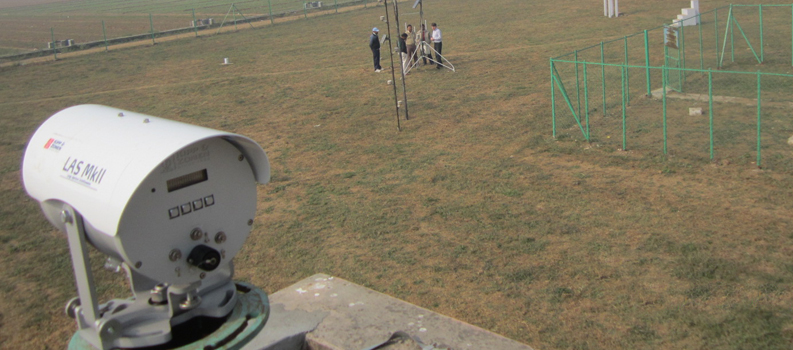Innovative technologies have made routine measurement of spatially averaged surface heat fluxes feasible and more accurate, and the scintillometry technique is one of the most promising methods. The Indian Institute of Remote Sciences (IIRS), Dehradun in collaboration with Indian Agricultural Research Institute (IARI), New Delhi chose the Kipp & Zonen LAS-MKII to conduct studies in Energy Balance.
The large aperture scintillometer (LAS) is an optical device for monitoring fluctuations in refractive index of the turbulent atmosphere over path lengths up to 4.5km that represent a relatively large area. With the accessory meteorological sensor kit the real-time sensible heat flux (H) can be calculated by the LAS MkII receiver and the data stored in its internal memory. When combined with net radiation and other meteorological data, the spatially averaged Evapo-transpiration (ET) can be derived by the EVATION software package.
The surface heat fluxes measured by the LAS are linked to latent heat flux (LvE) and evapotranspiration (ET), and thus could prove important in energy balance and water balance studies. Compared to traditional point measurement systems, the LAS-MkII operates at spatial scales comparable to the grid box size of numerical models and the pixel size of satellite images used in meteorology, hydrology and water management studies.
LAS-MkII operates at spatial scales
BKC WeatherSys installed the instrument at IARI over a path length of 990m, to estimate ET fluxes for an area of trial crop fields. IIRS and IARI will analyze the data obtained from the LAS MkII and compare it with a remote sensing based surface energy balance algorithm for land, using satellite data, to study an optimum effect on energy balance and water utilization for irrigation.
Installing the LAS MkII properly is a critical task, as variations in the alignment could reduce the received light signal below a usable level. The optimum location involved mounting the receiver and the metrological sensor kit mast on the roof of a small building and the construction of a stable tower and platform for the transmitter at 990m distance to provide a horizontal beam approximately 4.5m above the ground, to allow for the path length, expected heat flux ranges, and crop growth. Both receiver and transmitter are powered by solar panel and battery systems to allow for future relocation to other sites. BKC express their thanks to all from IARI and IIRS for their support in carrying out the LAS MkII installation successfully.
2-day training seminar
During the installation process a 2-day training seminar was presented for customer researchers, scientists and engineers and BKC staff by Clive Lee, Customer Services Specialist, from Kipp & Zonen in Delft.




